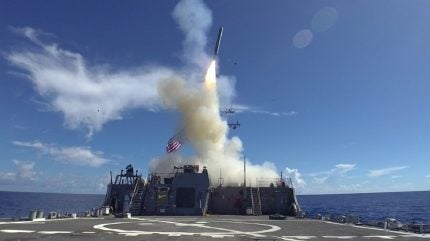
Germany has agreed to station US medium-range weapons on its soil from as early as 2026.
Such weapons can reach targets in Russia within a range of up to 2,500 kilometres, the German Ministry of Defence stipulated in a press release on 27 July 2024.

Discover B2B Marketing That Performs
Combine business intelligence and editorial excellence to reach engaged professionals across 36 leading media platforms.
The decision was made as a defensive measure against Russia’s long-range cruise missiles and rockets that could be equipped with both convnetional and nuclear warheads.
While the arrangement is a temporary precaution, it is a clear and necessary step-change in the strategic decision-making in Washington. It is a far cry from previous US efforts to limit what it had viewed as ‘escalatory measures’ such as providing increasingly lethal and effective means, such as F-16 fighters, to Ukraine.
The German Ministry of Defence added that it would have to be seen in the coming months where the planned US medium-range weapons would be stationed in Germany.
A balance in Europe
The planned deployment will employ three different systems: the Tomahawk cruise missile, SM-6 (Standard Missile) ballistic missiles and systems that can fly at multiple speeds of sound.

US Tariffs are shifting - will you react or anticipate?
Don’t let policy changes catch you off guard. Stay proactive with real-time data and expert analysis.
By GlobalData“What they all have in common is that they have a conventional role, that they are conventional systems – not nuclear systems – that they will be land-based,” emphasised Dr Jasper Wieck, the political director of the German Ministry of Defence. “They will have a range that goes far beyond what we have so far in the European part of the [Nato] alliance.”
European Nato members have so far had nothing to counter Russia’s longer range cruise missiles.
A nuclear tit-for-tat
Wieck affirmed that the deterrent will serve “as a response to a threatening, worrying development of the last ten years,” referring to Russia’s aggressive foreign and defence policy.
Besides the prevalence of nuclear sabre-rattling in Russian public discourse, the Kremlin has also demonstrated a willingness to opt for the nuclear option.
The country has recently conducted drills to deploy tactical nuclear weapons in May, and sent Russian warships and a nuclear-powered submarine for a port call to Cuba in June – a thinly veiled reference to the 1962 Cuban Missile Crisis.
US nuclear weapons have been deployed in Europe since the mid-1950s, when President Dwight D. Eisenhower authorised their storage at allied Nato bases on the continent for use against the Soviet Union.
Beyond the alliance’s three nuclear powers – France, the UK and US – five others members participate in US nuclear sharing. In 2021, the Center for Arms Control and Non-Proliferation estimated that there are 100 US-owned nuclear weapons stored across six bases: Kleine Brogel in Belgium, Büchel Air Base in Germany, Aviano and Ghedi Air Bases in Italy, Volkel Air Base in the Netherlands, and Incirlik in Türkiye.



